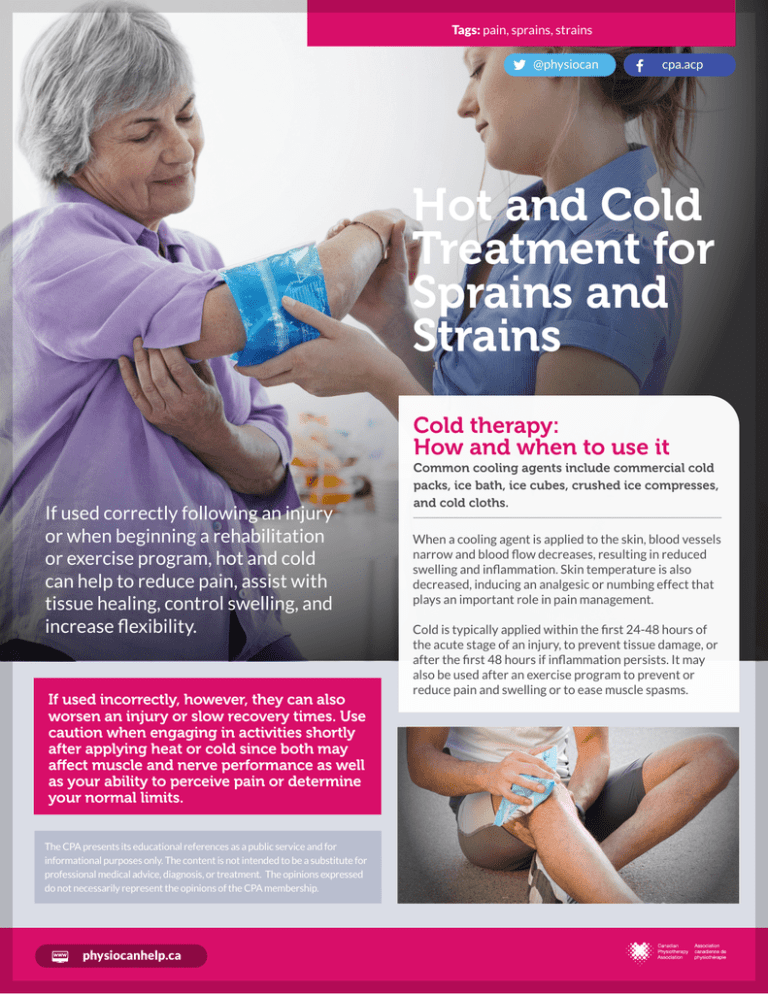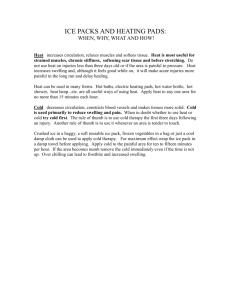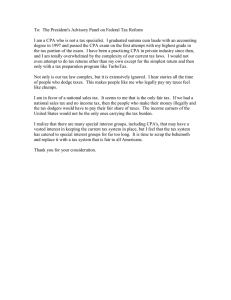Hot and Cold Treatment for Sprains and Strains
advertisement

Tags: pain, sprains, strains @physiocan cpa.acp Hot and Cold Treatment for Sprains and Strains Cold therapy: How and when to use it If used correctly following an injury or when beginning a rehabilitation or exercise program, hot and cold can help to reduce pain, assist with tissue healing, control swelling, and increase flexibility. If used incorrectly, however, they can also worsen an injury or slow recovery times. Use caution when engaging in activities shortly after applying heat or cold since both may affect muscle and nerve performance as well as your ability to perceive pain or determine your normal limits. The CPA presents its educational references as a public service and for informational purposes only. The content is not intended to be a substitute for professional medical advice, diagnosis, or treatment. The opinions expressed do not necessarily represent the opinions of the CPA membership. physiocanhelp.ca Common cooling agents include commercial cold packs, ice bath, ice cubes, crushed ice compresses, and cold cloths. When a cooling agent is applied to the skin, blood vessels narrow and blood flow decreases, resulting in reduced swelling and inflammation. Skin temperature is also decreased, inducing an analgesic or numbing effect that plays an important role in pain management. Cold is typically applied within the first 24-48 hours of the acute stage of an injury, to prevent tissue damage, or after the first 48 hours if inflammation persists. It may also be used after an exercise program to prevent or reduce pain and swelling or to ease muscle spasms. Tags: pain, sprains, strains @physiocan cpa.acp What about heat therapy? The PRICE protocol Follow the “PRICE” protocol to manage an injury in the early stages when swelling and pain are at their peak: Protection, Rest, Ice, Compression, and Elevation. After the initial application, cold therapy may be used periodically throughout the day for approximately 10 to 15 minutes at a time. It is important to use a damp towel between ice and the skin to increase effectiveness and decrease the risk of nerve or skin damage, which could lead to frostbite. Visually check the area of the body being treated with ice packs or other cooling agents every 5 minutes – while there may be discomfort and redness initially, treatment should be discontinued if these symptoms persist. Cold therapy is a good treatment option for many, however, it is generally not indicated as a treatment for people with: • • • • • • Impaired circulation or ischemia Absence of skin sensitivity (anaesthesia) Vasospasm (Raynaud’s disease) Open or infected wound Hypersensitivity to cold Acute dermatitis or eczema The Canadian Physiotherapy Association (CPA) represents physiotherapists, physiotherapist assistants and physiotherapist students across Canada. CPA members are rehabilitation professionals dedicated to the health, mobility and fitness of Canadians. Physiotherapists are primary health care professionals who combine their in-depth knowledge of the body and how it works with specialized handson clinical skills to assess, diagnose and treat symptoms of illness, injury or disability. More than 20,000 registered physiotherapists work in Canada, in private clinics, general and rehabilitation hospitals, community health centres, residential care and assisted-living facilities, home visit agencies, workplaces, and schools. physiocanhelp.ca Hot packs can be dry such as electric pads, hot water bottles and gel packs, or moist such as damp clay packs used in physiotherapy clinics and hospitals. Hot packs dilate blood vessels and increase blood flow, delivering needed nutrients and oxygen to cells in the area being heated, aiding the removal of cell waste and promoting healing. Therapeutic heat is often used in the chronic phase of an injury. It may also be used prior to physiotherapy or exercise to decrease muscle tension and increase flexibility and range of motion. It also plays a role in pain management and reduction of muscle spasms, muscle tension and joint stiffness. Heat therapy should be avoided in the acute phase of an injury when swelling is present and the skin is hot to touch. Moist heat is preferred over dry heat since it penetrates deeper to reach muscles, ligaments and joints. To create the effects of moist heat at home when using a nonelectrical heat source, first wrap a damp towel around the hot pack then cover it with dry toweling before applying it to the treatment area. No matter the type of heating agent used, several layers of toweling should be used as a barrier between the skin and the hot pack to help prevent skin irritation or burns. Hot packs should be applied for 15 to 20 minutes. Visually check the skin every 5 minutes and discontinue treatment if there are abnormal changes in skin colour or you experience increased discomfort. Do not lie on a hot pack or apply heat when going to sleep since it increases the likelihood of burns resulting from close or prolonged contact with the heat source. Heat therapy is a good treatment option for many, however, it is generally not indicated for people with: • • • • • • • • Decreased sensation to heat Impaired circulation Areas of recent bleeding or severe bruising Open wounds Areas that are infected or ischemic Cancer if treating the region over the tumour site Tuberculosis if applying treatment over a lesion Swelling or acute inflammation




